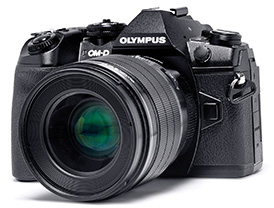 Ergonomics
Ergonomics
The E-M1 II is quite lightweight for a sturdy magnesium alloy body. The grip is deep and finished with textured rubber to provide excellent grip. All controls are well within reach, and are user-friendly. The fully-articulating monitor allows you to exploit a wide range of perspectives and protects the LCD when not in use. Images were crisp on both EVF and LCD. We never felt any eye strain while using either of them. The camera retains the same extensive menu, often dubbed as ‘confusing’, but this time, Olympus has made the custom menu a little more user-friendly with a secondary menu inside. The quick menu can be accessed by pressing the OK button, which is least expected. Overall, the camera is confusing to begin with, but things become smooth once you get used to the system. For people who still think the menus are confusing, this camera has 12 customisable buttons!
Performance
The E-M1 Mark II performed very well with the supplied 25mm f/1.2 PRO lens. Autofocus was quick and silent, and the system latched on to subjects easily even in low light. Metering was perfect and out-of-thebox JPEGs appeared quite sharp.
The camera produces images with a native print size of 11.52 x 17.28 inches at 300 ppi. At 25 percent of the screen size, images were absolutely free of noise up to ISO 1600. Slight noise appeared at ISO 3200, though these were perfectly usable up to ISO 6400. Higher ISOs were practically useless. Viewed at 50 percent, images were absolutely free of noise up to ISO 800. A tinge of noise appeared from ISO 1600, but the images were usable up to ISO 3200. At 100 percent, ISO 64 (LOW) appeared spotless. Images were usable up to ISO 400.
The camera allowed us to capture Raw images at a continuous rate of 15 frames per second in default mode, which confirms the claims by Olympus. We obtained 75 frames in 5 seconds and the camera shot 57 Raw images before it hesitated a bit. We used a Sandisk Extreme Pro card with a marked speed of 95 MB per second for the tests. Pro Capture mode was so fast that even the 95MB per second card was unable to keep up with it. So we were unable to verify the actual speed in this mode. In a single press and release of the button, the camera captured about 23 images, which is amazing.
Auto White Balance performed as expected with the camera reproducing colours true to the original. Slight cast produced under incandescent and fluorescent lights could be removed easily during postprocessing. Videos were crisp and autofocus was smooth.
Value for Money
The E-M1 Mark II body retails at an MRP of Rs.1,45,490. The camera is available in kit form with the 12- 40mm PRO lens at Rs.1,96,490. This seems to be good value for money. |SP
FINAL SCORE 88%
Design and Build Quality 20/20
Key Features 19/20
Ergonomics 17/20
Performance
Autofocus 4.5/5
Metering 4/5
Noise Control 3.5/5
Sharpness 4/5
LCD/EVF 4/5
Auto WB 4/5
Sub-Total 24/30
Value for Money 8/10
PLUS
• Sturdily built
• Weather-sealed body
• Ergonomic design
• Fully articulated display
• Feature-packed
• 5-axis stabilisation
• Cinema 4K
• Stunning performance
MINUS
• Menu can be confusing for some
VERDICT
Micro Four Thirds Standard is here to stay, and this camera is proof of that. If you are looking for a professional quality interchangeable lens camera that is compact, lightweight and easy to lug around, the Olympus E-M1 Mark II certainly fits the bill. It is true that the cropped sensor does not come close to a full frame system in noise control. However, if you are a frequent traveller, your shoulders will thank you for opting for this system. Combined with the PROseries lenses, the camera is a Best Buy.
Sujith Gopinath


